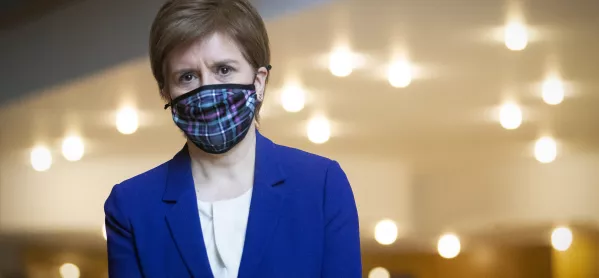MSPs demand more time in school for secondary students

First minister Nicola Sturgeon has faced criticism in the Scottish Parliament today over the plans for secondary school students to return to school part-time from Monday.
Opposition MSPs expressed concern about reports that some students could spend under two hours a week in classrooms. However, a number of teachers have pointed out that strict social distancing rules severely limit what they can do with in-school classes.
The first minister said that, despite the fall in coronavirus case numbers, expert advice does not yet support all secondary school students returning full-time to face-to-face learning.
Back to schools? Student return ‘less than billed’, says Ruth Davidson
Timetabling: Seven tips from a headteacher for Covid school timetables next week
Covid: Headteachers blindsided by ‘shock’ school return plans
Reaction: Four reasons why the schools update was ‘baffling and concerning’
While all children will be back in primary school from Monday 15 March, secondary school students will only receive some in-school education, with a blended approach meaning they will continue to do some of their learning at home until after the Easter break.
The decision that S1-3 secondary students will return to school buildings for some teaching from 15 March through to the Easter holidays came as a shock when it was announced on 2 March.
Schools reopening: Not possible to get all secondary students back full-time, says Sturgeon
Ms Sturgeon said today: “We would not have been able to say to secondary school pupils, ‘Everybody can be back full-time from 15 March.’
“So it was a choice between some limited in-school provision or no in-school provision at all.”
But Scottish Liberal Democrat leader Willie Rennie told her: “The amount of education for S1 to S3 students seems to vary from one day a week to one hour and 45 minutes for some.”
Speaking at a meeting of the Scottish Parliament’s Covid-19 Committee today, he added: “There are lots of angry parents out there.”
Mr Rennie argued that “most parents” think the blended learning system will “adversely impact” the education that their children receive.
“Teachers and school leaders are pretty clear there is a diminished educational offer for these two weeks,” he added.
Ms Sturgeon said: “We want to get young people back into school full-time. We achieved that in August and we think that can be achieved again, and our aim is for that to be possible after the Easter break.”
But she added that for secondary school students, ministers had to decide if the focus should be entirely on S4-6s, who are working towards qualifications, or if S1-3s should also be able to get some time back in the classroom.
Ms Sturgeon said that even if the time they have in school is “limited”, the government had decided on this approach because of concerns over “not just the educational impact of being out of school 100 per cent of the time, but the wellbeing impact as well, being separated from friends and normal life”.
She added: “We decided to try, even if it was limited, in the period between now and Easter to get young people back into school for some periods and to reacquaint them ahead of the Easter holidays.
“We are trying to get back to the provision of full-time education as quickly as is possible, and to recognise the need to introduce, even if it is partial, and even if it is phased, and even if it is limited, greater degrees of normality for young people from now onwards.”
Register with Tes and you can read two free articles every month plus you'll have access to our range of award-winning newsletters.
Keep reading with our special offer!
You’ve reached your limit of free articles this month.
- Unlimited access to all Tes magazine content
- Save your favourite articles and gift them to your colleagues
- Exclusive subscriber-only stories
- Over 200,000 archived articles
- Unlimited access to all Tes magazine content
- Save your favourite articles and gift them to your colleagues
- Exclusive subscriber-only stories
- Over 200,000 archived articles



